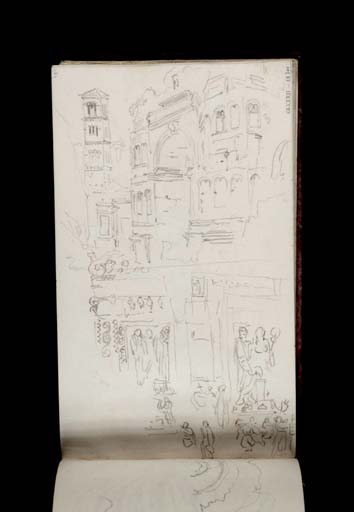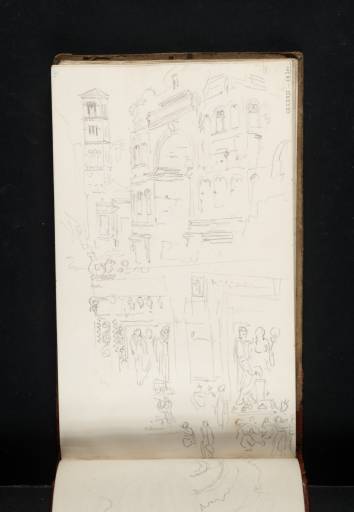Joseph Mallord William Turner Two Sketches in Rome: San Giorgio in Velabro and the Arch of Janus; and the Sculptures on the Arcus Argentariorum 1819
Image 1 of 2
-
 Joseph Mallord William Turner, Two Sketches in Rome: San Giorgio in Velabro and the Arch of Janus; and the Sculptures on the Arcus Argentariorum 1819
Joseph Mallord William Turner, Two Sketches in Rome: San Giorgio in Velabro and the Arch of Janus; and the Sculptures on the Arcus Argentariorum 1819 -
 Joseph Mallord William Turner, Two Sketches in Rome: San Giorgio in Velabro and the Arch of Janus; and the Sculptures on the Arcus Argentariorum 1819 (Enhanced image)Enhanced image
Joseph Mallord William Turner, Two Sketches in Rome: San Giorgio in Velabro and the Arch of Janus; and the Sculptures on the Arcus Argentariorum 1819 (Enhanced image)Enhanced image
Joseph Mallord William Turner,
Two Sketches in Rome: San Giorgio in Velabro and the Arch of Janus; and the Sculptures on the Arcus Argentariorum
1819
Joseph Mallord William Turner 1775–1851
Folio 45 Recto:
Two Sketches in Rome: San Giorgio in Velabro and the Arch of Janus; and the Sculptures on the Arcus Argentariorum 1819
D15380
Turner Bequest CLXXXII 45
Turner Bequest CLXXXII 45
Pencil on white wove paper, 189 x 113 mm
Inscribed by John Ruskin in blue ink ‘45’ top left, asecending left-hand edge and ‘301’ top right, ascending right-hand edge
Stamped in black ‘CLXXXII 45’ top right, ascending right-hand edge
Stamped in black ‘CLXXXII 45’ top right, ascending right-hand edge
Accepted by the nation as part of the Turner Bequest 1856
References
1909
A.J. Finberg, A Complete Inventory of the Drawings of the Turner Bequest, London 1909, vol.I, p.537, as ‘An archway (ruined) and basilica; also details of ornament and relief’.
1984
Cecilia Powell, ‘Turner on Classic Ground: His Visits to Central and Southern Italy and Related Paintings and Drawings’, unpublished Ph.D thesis, Courtauld Institute of Art, University of London 1984, pp.112, 138, 423, pl.78, as ‘S. Giorgio in Velabro and the Arch of Janus; (below) the sculptures on the Arcus Argentariorum’.
1987
Cecilia Powell, Turner in the South: Rome, Naples, Florence, New Haven and London 1987, pp.51 note 8, 57, reproduced pl.64, as ‘The Arch of Janus and the reliefs on the Arcus Argentariorum’.
The subject of the sketch on the top half of this page is the Arch of Janus in the Forum Boarium, with the adjacent bell-tower of San Giorgio in Velabro. Both buildings are located near the present-day Piazza del Bocca dell Verità, close to the Temples of Hercules the Victor and Portunus, which Turner also sketched, see folio 37 verso (D15365). The Arch of Janus is a fourth-century monument which owes its names to its quadrifons structure, the double facing arch and four identical fronts recalling the Roman two-faced God of gates and doors. According to Charlotte Eaton there were few ruins ‘more picturesque and venerable. Its niches are empty; its statues, its pillars, its sculptured monuments, are all destroyed; and wild weeds, thick matted bushes, and aged ivy, wave luxuriantly from its top, and cling to its grey walls.’1 In medieval times the arch formed the base of a tower fortress and Turner’s sketch of the northern face shows the remains of an entablature and attic at the top of the structure. By the time of his second visit to Rome in 1828, this layer had been removed since it was believed, probably erroneously, not to be part of the original arch.2
The details of sculptural reliefs on the bottom half of the page belong to the Arcus Argentariorum (Arch of the Money-Changers), an ancient monumental structure dedicated to the Emperor Septimius Severus by the merchants and money lenders of the Forum Boarium district. The arch is partially incorporated into the south-west corner at the front of San Giorgio in Velabro.3 Amongst the elements Turner has recorded is the decorative acanthus scroll detailing which runs vertically up the marble posts, two of the main figurative panel reliefs from the outer and inner faces, and some of the smaller sacrificial scenes underneath.
Cecilia Powell notes that this kind of indiscriminate sketching practice, combining different places or objects on the same page without adequate labelling of the individual components, might have led Turner to make mistakes in his use of the studies for oil compositions.4
Nicola Moorby
May 2008
How to cite
Nicola Moorby, ‘Two Sketches in Rome: San Giorgio in Velabro and the Arch of Janus; and the Sculptures on the Arcus Argentariorum 1819 by Joseph Mallord William Turner’, catalogue entry, May 2008, in David Blayney Brown (ed.), J.M.W. Turner: Sketchbooks, Drawings and Watercolours, Tate Research Publication, December 2012, https://www

